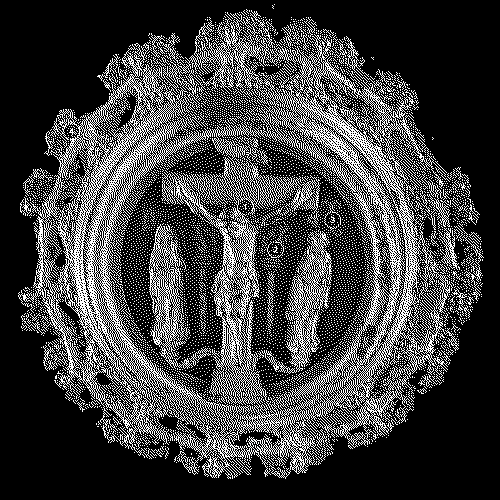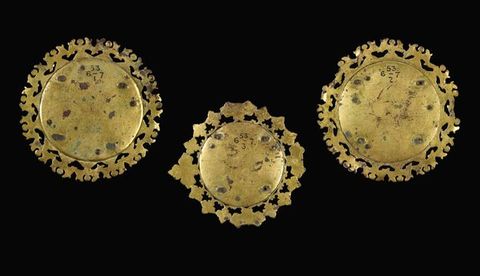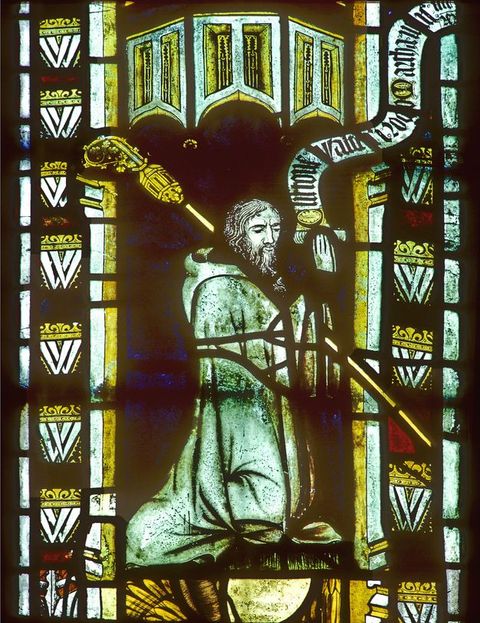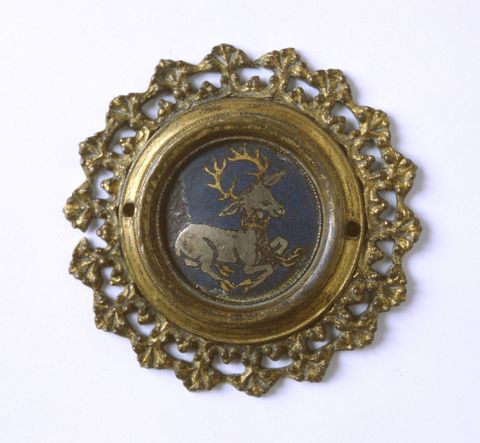Morse Decorated with the Crucifixion and the Monogram of Abbot Walter Clifton of Warden Abbey
Morse Decorated with the Crucifixion and the Monogram of Abbot Walter Clifton of Warden Abbey
By Michael Carter
The circular copper-gilt plaque (fig. 2) is decorated with a relief of the Crucifixion with the Virgin and St John. The dead Christ hangs on the cross beneath the titulus inscribed INRI. The flanking figures stand on pedestals, joined to the cross by curved brackets. The scene is set against a blue enamel background decorated with pastoral staffs and the initials “W C” in Lombardic script. The plaque, and two similar pieces, were bought by the British Museum in 1853, having been found at Shefford, close to the site of Warden Abbey, Bedfordshire. The first of the other plaques (fig. 3) is decorated with a mount of the Virgin and Child flanked by enamel shields with the coat of arms azure, three pears, or, heraldry used by Warden Abbey. The second (fig. 4) has a mount with a relief of a shield-holding angel. The shield is inscribed with the initials “W C”, each letter surmounted by a crown. Between the initials is a pastoral staff. On the reverse of each of the plaques are fragments of suspension loops (fig. 5).1
1



The plaque and its companion pieces were most likely morses, an ornament used to fasten copes, a cloak-like vestment worn for processions. Sets of such morses are mentioned in several medieval and Reformation-era inventories.2 The heraldic ornament and site of discovery leaves little doubt that these plaques are from Warden Abbey, a mid-ranking Cistercian house founded in 1136. By the late Middle Ages most, if not all, major monasteries had their own coat of arms. It was also common for heads of religious houses to adopt the use of personal heraldry, including monograms. Typically, these consisted of their prelate’s initials combined with a pastoral staff.3 The initials on the plaque under discussion can be identified as those of Walter Clifton, abbot of Warden between about 1346 and 1397. He is depicted in a stained glass window datable to 1381–82 at the parish church of St Laurence, Old Warden (fig. 6), where he is shown kneeling in supplication to St Martha. The borders of these lights are set with small panels, each of which has a Lombardic letter “W” with a crown above.4 These are similar to the abbot’s badge on one of the roundels, and can also be compared to the monogram used by Clifton’s contemporary, Abbot Nicholas Litlyngton of Westminster Abbey (1362–86) in his great Missal.5
2
Identifying Clifton as the patron dates the plaque to the late fourteenth century, which is supported by comparative evidence. As Marian Campbell recognized, the closest parallel is the plaque at the Musée des Beaux-Arts, Troyes (fig. 7), decorated with the white hart badge of Richard II (r. 1377–99), which was probably a broach of some kind.6
6
The hand-holding angels around the rim of the Warden plaque are an unusual iconographic detail and are of devotional significance. St Bernard of Clairvaux, the greatest of all Cistercian saints, regarded angels as a model for communal life within a monastery, and in one of his sermons stated that “angelic hands” supported the monks. Devotion to angels was also gaining wider popularity during the reign of Richard II.7
7About the author
-
Michael Carter is a Senior Properties Historian at English Heritage. He was previously Andrew Mellon Postdoctoral Fellow at the Courtauld Institute of Art, where he was awarded his PhD. He has published widely on monastic art and architecture in late medieval England.
Footnotes
-
1
For a detailed analysis, see M. Carter, “Cracking the Code: The Warden Abbey Morses, Luxury Metalwork and Patronage at a Cistercian Abbey in the Late Middle Ages”, Antiquaries Journal 91 (2011): 175–93. ↩︎
-
2
Examples are cited in Carter, “Cracking the Code”, 188–90. ↩︎
-
3
For a discussion of the use of heraldry by heads of religious houses, see M. Heale, “Mitres and Arms: Aspects of the Self-Representation of the Monastic Superior in Late Medieval England”, in Self-Representation of Medieval Religious Communities: The British Isles in Context, ed. A. Müller and K. Stöber (Berlin, 2009), 99–124. ↩︎
-
4
R. Marks, “Cistercian Window Glass”, in Cistercian Art and Architecture in the British Isles, ed. C. Norton and D. Park (Cambridge: Cambridge University Press, 1986), 225–26. ↩︎
-
5
J. Backhouse, “The Litlyngton Missal”, in Age of Chivalry: Art in Plantagenet England, 1200–1400, ed. J. Alexander and P. Binski (London: Royal Academy, 1987), 518–19. ↩︎
-
6
M. Campbell, “Badge of Richard II”, in Age of Chivalry, ed. Alexander and Binski, 524. ↩︎
-
7
Carter, “Cracking the Code”, 185–86. ↩︎
Bibliography
Alexander, J., and P. Binski, eds. Age of Chivalry: Art in Plantagenet England, 1200–1400. London: Royal Academy, 1987.
Backhouse, J. “The Litlyngton Missal.” In Age of Chivalry, ed. Alexander and Binski, 518–19.
Campbell, M. “Badge of Richard II.” In Age of Chivalry, ed. Alexander and Binski, 524.
Carter, M. “Cracking the Code: The Warden Abbey Morses, Luxury Metalwork and Patronage at a Cistercian Abbey in the Late Middle Ages.” Antiquaries Journal 91 (2011): 175–93.
Heale, M. “Mitres and Arms: Aspects of the Self-Representation of the Monastic Superior in Late Medieval England.” In Self-Representation of Medieval Religious Communities: The British Isles in Context, ed. A. Müller and K. Stöber. Berlin, 2009, 99–124.
Marks, R. “Cistercian Window Glass in England and Wales.” In Cistercian Art and Architecture in the British Isles, ed. C. Norton and D. Park. Cambridge: Cambridge University Press, 1986, 211–27.
Imprint
| Author | |
|---|---|
| Date | 29 June 2017 |
| Category | One Object |
| Review status | Peer Reviewed (Editorial Group) |
| License | Creative Commons Attribution-NonCommercial 4.0 International (CC BY-NC 4.0) |
| Downloads | PDF format |
| Article DOI | https://doi.org/10.17658/issn.2058-5462/issue-06/morses |
| Cite as | Carter, Michael. “Morse Decorated with the Crucifixion and the Monogram of Abbot Walter Clifton of Warden Abbey.” In British Art Studies: Invention and Imagination in British Art and Architecture, 600–1500 (Edited by Jessica Berenbeim and Sandy Heslop). London and New Haven: Paul Mellon Centre for Studies in British Art and Yale University Press, 2017. https://doi.org/10.17658/issn.2058-5462/issue-06/morses. |
